Abstract
MercLokTM P-640 (MercLok) is a proprietary product developed by Albemarle as a mercury (Hg) treatment technology. MercLok captures mercury and sequesters it for a long period under ambient environmental conditions. For this project, MercLok was applied to Hg-contaminated calcines at two abandoned Hg mine sites in northern California to evaluate its efficacy in rendering such contaminated materials less hazardous and thereby reducing remediation project costs. The first application (Site 1) consisted of two calcines amended with MercLok in isolated reactor buckets under two hydrologic remediation approaches (“repository cap” and “reactive barrier”) while exposed to ambient environmental conditions. Non-amended and amended calcines and their leachates were analyzed for Hg content and related conditions during a five-month study period, demonstrating >95% reduction in leachable Hg. The second application (Site 2) involved full-scale site remediation with the application of both approaches and additional hydrologic controls to minimize run-on, erosion, and runoff. Confirmation sampling and subsequent observations indicate that the amendments and hydrologic controls effectively stabilized the site and minimized Hg releases. These application projects demonstrate the efficacy of MercLok as a component of hydrologic controls for treating Hg-contaminated material to achieve long-term mine site remediation objectives.
1. Introduction
California experienced significant mining activity during the 19th and 20th centuries, including hard rock and hydraulic gold mining (primarily in the Klamath Mountains and Sierra Nevada), mercury (Hg) mining in the Coast Range, and hard rock mining for copper, silver, and other metals in portions of the Sierras and northern Coast Range. California’s Coast Range represents one of the world’s five major Hg-mining areas [1].
The basic Hg processing systems crush Hg-rich ore, roast it in a retort or furnace to volatilize the Hg, and recover the Hg vapor in condenser tubes [2]. The roasted material, called “calcine”, is typically dumped in a pile on site. These Hg recovery processes produce calcines that are exposed to the environment at the site. Mercury recovery also requires cooling water to facilitate the condensation of the Hg vapor. For this reason, most processing areas and calcines are located adjacent to water sources. While the most abundant Hg ore mineral is cinnabar (HgS), the calcines after roasting contain a variety of other Hg species, including readily soluble Hg sulfate and Hg chloride species [3]. Thus, calcines at abandoned Hg mine sites provide a source of environmentally reactive Hg that is readily mobilized via erosion and leaches into nearby surface water.
One pervasive legacy of these mining activities is elevated concentrations of Hg in soils, streams, and reservoirs covering vast areas of the state. Most waterbodies downstream of these mines are now listed by the state as impaired [4], and fish consumption advisories are posted [5].
Remediating mine sites can provide environmental improvements on site and downstream [6]. The successful remediation of Gambonini Mercury Mine in 2000 by state and federal agencies [7] provided an example in the same region, wherein consolidating mine waste and deploying subsequent hydrologic and erosion controls reduced the amount of particulate-bound Hg transported off-site via surface water. The remediation of the Gambonini Mine did not address the leachability of Hg from calcines.
Albemarle researched and developed the remediation amendment product MercLokTM P-640 (hereafter “MercLok”) to capture and sequester Hg. The purposes of the projects reported here were to quantify the effectiveness of MercLok in minimizing the leachability of Hg, and to gain experience in applying MercLok to remediate Hg mine sites. The successes in both cases are significant because they demonstrate the effectiveness of a new remediation tool that efficiently enhances the effectiveness of hydrologic controls at mine sites.
2. Project Approach
This project applied MercLok at two abandoned Hg mine sites in California’s Coast Range. This region is characterized generally as having a Mediterranean climate with arid, warm summers, relatively wet winters, and moderate temperatures. Both sites were mined at multiple times with a variety of devices [8], leaving multiple piles of calcines. Both sites are subject to regulatory pressure to address impaired downstream waters. One site owner wishes to remain anonymous. Thus, for consistency, they are referred to herein as Site 1 and Site 2.
The first project, at Site 1, conducted field trials in containers. The study goal was to evaluate the absolute and relative effectiveness of multiple treatment options (material amended, amendment product, amendment dose and configuration) for controlling the hydrology-driven leaching of Hg, and the erosion of three generations of Hg-rich calcines. The configurations are meant to represent the performance of a “repository cap” and a permeable “reactive barrier”. Site features were identified based on a literature review and observations made during site assessment visits. In particular, two piles of calcines (generated during different mining eras) were identified for treatment trials as Areas of Concern 6 and X (AOC-6 and AOC-X).
The second project, at Site 2, implemented full-scale treatment (using multiple hydrologic controls, including MercLok in both repository cap and reactive barrier configurations) amending a pile of calcines. Background soil samples (serpentinite, silica carbonate rock, and sandstone-siltstone) reflected unmineralized rock with Hg concentrations below 1 milligram per kilogram (mg/kg) and mineralized rock with Hg concentrations of 120 to 350 mg/kg. The remediation goals for this site were to reduce the risks of (1) water quality degradation posed by calcines and (2) human and wildlife exposure to Hg in the on-site calcines. These goals were achieved by implementing three primary hydrologic controls: (1) a repository cap—amending calcines with MercLok to reduce Hg leachability from direct precipitation and throughflow; (2) a reactive barrier—amending the material in permeable, subsurface, perimeter trenches; and (3) surface flow controls—installing surface hydrologic controls to minimize run-on, runoff and associated erosion of the amended calcines.
The project proponents addressed the following environmental regulations:
- The Comprehensive Environmental Response, Compensation, and Liability Act (Superfund) regulating releases of hazardous substances that pose unacceptable risks to human health and the environment;
- The Clean Water Act regulating discharges of pollutants into waters of the USA;
- California’s Water Code regulating mine waste and drainage, as well as discharges of pollutants into waters of the state.
3. Activities
At both sites, samples were analyzed for:
- Total metals—Required for a general understanding of the metal concentrations and comparison with California Title 22 total threshold limit concentrations (TTLC, a hazardous waste criterion). The threshold for total mercury is 20 mg/kg.
- Toxicity characteristic leaching potential (TCLP)—Required for federal hazardous waste characterization. This procedure is used to simulate a landfill environment and to determine how much of a regulated compound will leach into the environment. None of the Site 1 or Site 2 samples were classified as hazardous based on TCLP analysis; therefore, TCLP results are not discussed further herein.
- Waste extraction test (WET) metals—Used to evaluate the change in hazard classification of calcines due to treatment with MercLok. Compounds are analyzed by extracting Hg from a sample with a 10:1 ratio of citric acid solution to solid. The California hazardous soluble threshold limit concentration (STLC) for the leachability of Hg is 0.2 mg/L.
- De-ionized waste extraction test (DI WET) metals—A WET test in which DI water is used as the extracting solution, which characterizes the amounts of metals that would leach from material under the conditions most likely to be encountered at the site, was used to assess potential threats to water quality. The California Toxics Rule limitation is 0.05 µg/L.
- Synthetic precipitation leaching procedure (SPLP)—Developed by the federal Environmental Protection Agency (EPA) to evaluate the impact of contaminated soils on groundwater.
Based on these analyses and field observations of surface and groundwater hydrology, calcines at Site 1 were the focus of amendment testing to compare the two hydrologic controls, namely a repository cap and reactive barrier. Calcines at Site 2 were treated with all three hydrologic controls (that is, both treatment configurations plus surface flow controls).
- Site 1 Activities
Analyses showed that AOC-X and AOC-6 materials were calcines from different generations of ore processing. Two composite surface samples of soil were collected uphill of the mining site and were used to represent the background soil Hg concentrations. Table 1 below shows the Hg-specific results of lab testing.

Table 1.
Key analytical results for the testing of Site 1 materials during setup.
Based on DI WET extract Hg concentrations, both non-amended calcines pose a threat to water quality at the site and are considered Group B mine waste, while non-amended AOC-X calcines are considered as California hazardous waste. MercLok-amended calcines are classified as Group C mine waste based on DI WET extract Hg concentrations (and amended AOC X calcines were no longer characterized as hazardous). California mining regulations require much less stringent containment for Group C waste compared to Group B waste.
Field test material was obtained using hand tools (pick and shovel). MercLok amendment doses (as weight percent amendment) decided based on laboratory bench tests were 0 (non-amended “controls”), 1 wt%, 5 wt%, and 10 wt%. The materials and amendments were weighed and placed into a cement mixer. The amended and non-amended materials were placed directly into reactor buckets for testing in two configurations.
The repository cap configuration consisted of a layer of amended calcines on top of clean sand. The reactive barrier configuration consisted of a layer of amended calcines on top of clean sand, covered with a layer of non-amended calcines. Non-amended buckets were configured in the same way.
These two configurations were mimicked on site, as shown in Figure 1. Site photos are provided separately in Figure S1. Each reactor was a plastic 49 L bucket with a 30 cm layer of coarse sand in the bottom. A PVC pipe with a 1.3 cm inner diameter that was open at the bottom and perforated along the bottom 25 cm was placed in the sand/gravel layer. The PVC pipe extended to the top of the bucket to serve as a measuring and sampling port. All reactor buckets were contained in stock tanks to prevent the discharge of study-related materials to the site.
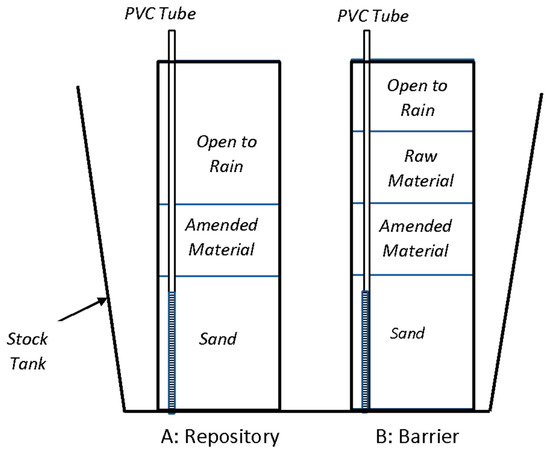
Figure 1.
Schematic diagram of Site 1 amended material in buckets configured to mimic a repository cap (A) and reactive barrier. (B) Not to scale.
Each repository cap, reactive barrier and non-amended sample (14 L each) was placed into its respective bucket and manually distributed as needed to cover the sand and touch the sides of the bucket. The resulting thickness was about 16.5 cm. Reactive barrier layers (including non-amended controls) were then covered with another 16.5 cm of non-amended material.
Monitoring consisted of approximately monthly visits during the wet season. Solids were sampled at the beginning and end of the five-month study period. Samples were analyzed at California Laboratory Services (California Water Boards Environmental Laboratory Accreditation Program (ELAP) certificate # 1233) for the TCLP of metals, WET metals, DI WET metals, and total metals. Samples were analyzed at Eurofins Environment Testing in West Sacramento, CA, using the synthetic precipitation leaching procedure (SPLP) (ELAP # 2897).
The leachate was sampled, approximately monthly after the first month, by placing tubing through the PVC pipe and using a peristaltic pump to withdraw water from the sand layer. Because the study occurred during a significant drought, the lack of rainfall was supplemented with DI water to represent normal seasonal precipitation levels. Samples were analyzed for (among other metals) total and filtered Hg, total suspended solids, cations and anions, and field parameters (pH, temperature and specific conductance). The volume of water needed to fill the sample containers for these analytes was about 2.5 L. Field parameters (pH, specific conductance, and temperature) were measured with calibrated field meters.
- 2.
- Site 2 Activities
At Site 2, calcines and background soil samples were sampled, and a subset were amended with MercLok. Several analyses were used to characterize the material, but key for this paper is that based on WET extract concentrations, the calcines were characterized as a California hazardous waste, and based on DI WET extract Hg concentrations, the calcines posed a threat to water quality at the site. Site 2 non-amended calcines were considered Group B mine waste. MercLok-amended calcines are classified as Group C mine waste based on WET and DI WET extract concentrations. In accordance with Title 27 §22480(d), another factor considered in the classification of the amended calcines as Group C mine waste is that amending the calcines with MercLok constitutes treatment to minimize the threat to water quality and minimizes the need to install waste containment structures.
Hydrologic controls implemented for Site 2 are shown in Figure 2. Site photos are provided separately in Figure S2. Hydrologic controls included, from upstream to downstream:
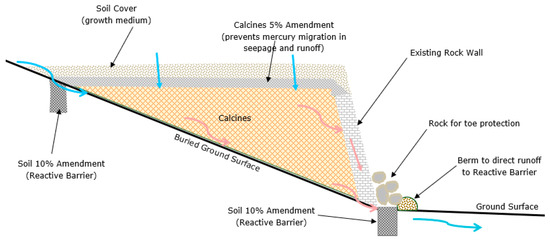
Figure 2.
Site 2 amended calcine pile’s vertical cross-sectional design. Blue arrows show the flow paths of infiltrating water that does not contain leachable Hg. Pink arrows show the flow paths of seepage that could contain Hg. The reactive barrier at the downslope edge of the calcines is intended to prevent the migration of Hg through the amended seepage face.
- An access road low water crossing to reconnect perennial spring discharge with a natural channel away from edge of calcines.
- Grading, mulching, seeding native grasses, and straw wattles on all bare soils to retain moisture, slow overland flow and promote stabilizing vegetation.
- A berm and ditch above the site to divert runoff around the pile.
- An upstream reactive barrier and an overlying berm to direct surface run-on and interflow through the reactive barrier for treatment.
- A repository cap to treat the pile surface.
- A rock retaining wall on downstream pile slope.
- A downstream reactive barrier and an overlying berm to direct surface runoff and interflow through the reactive barrier for treatment.
4. Technologies
Albemarle’s amendment product, MercLokTM P-640 (hereafter “MercLok”; www.albemarle.com), is a brominated porous material with a unique ability to capture and sequester mercury. Multiple forms of Hg found in a range of soils and industrial wastes can be transformed and interact chemically with MercLok, resulting in the long-term sequestration (i.e., remediation) of mercury by the product. With high efficacy and low loading requirements, the powder-based material can be delivered in 454 kg “supersacks” and applied using basic techniques for moistening and mixing into contaminated material. We believe that in most cases, MercLok’s cost-in-use value is lower than that of other amendments due to MercLok’s higher efficacy in capturing and sequestering Hg in the long term.
Using industry-accepted analyses [9,10,11], studies predict long-term stability across a range of soils and conditions. MercLok is not classified as a skin or respiratory sensitizer or as toxic through inhalation, oral or dermal exposure. Environmental toxicology tests on indicator species in water and soil (daphnia, fathead minnow, redworms) suggest that the current product has a favorable safety profile for its intended use at contaminated sites. No acute toxicity with up to 10 wt% MercLok was observed from soil biota using OECD Method 207 [12]. Ecotoxicity studies with MercLok using indicator species (water fleas and fatheaded minnows) confirmed that MercLok is not categorized as an aquatic toxin [13,14]. See Supplementary Technology Information for additional reading.
5. Project Details
Field test results (Site 1) and remediation performance results (Site 2) are presented in this section.
- Site 1 Details
For Site 1, samples of the amended material quantify Hg mobility prior to and after amendment and during and after several months of exposure to weather at the site. The dates of such samples are set forth in Figure 3. The effectiveness of the amendments is assessed via the comparison of Hg concentrations detected in leachates created by the exposure of the materials to weather at the site, with background soil leachates and water quality protection-based thresholds, and through the comparison of the pre- and post-trial solid results with relevant thresholds.

Figure 3.
Site 1 total Hg in AOC-X leachate shows that MercLok significantly reduced leachability.
Samples of the leachate that passed through the buckets were collected four times during the field study. The total Hg leached by the rainwater through the AOC-X buckets with MercLok-amended calcines (two duplicates with 5 wt% and a third with 10 wt% doses) was compared with that in the control buckets (Figure 3). These results demonstrated a 97% reduction in leachable Hg as compared to the control.
Total and leachable Hg concentrations from amended AOC-6 were much lower than non-amended AOC-X. Thus, the differentiation between the AOC-6 control and the AOC-6 amended calcines was commensurately lower as well. AOC-6 calcines were amended with 1 wt% and 5 wt% MercLok and arranged in both configurations. Both configurations using MercLok demonstrated significant reductions in the leachable Hg to levels even below the leachability of background soil (Figure 4). Even by assuming non-detected values at the detection limit and including the outlier in the amended samples, there is a significant reduction from the control to amended AOC-6 DI WET Hg (p = 0.0479; alpha 0.05%). Furthermore, even though the reactive barrier configuration nominally held twice as much total Hg as the repository cap configuration, there was no difference in the leachable Hg (except for one outlier).
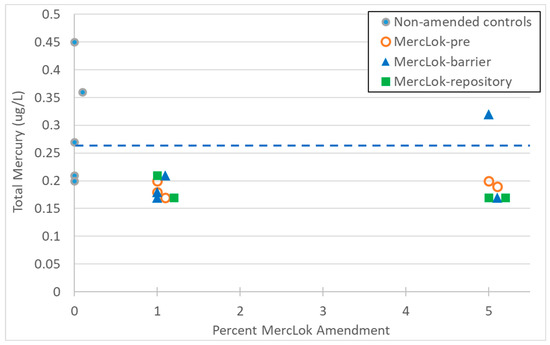
Figure 4.
Site 1 Hg in DI-WET leachate from each reactor bucket shows that MercLok reduced the leaching of Hg from AOC-6 to concentrations below that of background soil.
Samples for methylmercury (methyl Hg) in leachate were taken during the second and final sampling periods and only from buckets with 5 wt% of MercLok dosed into AOC-6 and AOC-X. Methyl Hg concentrations in leachates were reduced by 77% and 78% from AOC-6 (Figure 5) and 76% from AOC-X (Figure 6). Since other testing has shown that methyl Hg reduction has a similar slope to total Hg, it is expected that the analysis of methyl Hg from the 10 wt% dosages of MercLok in AOC-X would have resulted in even greater reductions. The analytical results for other total metals in leachate are available in Supplementary Table S1.
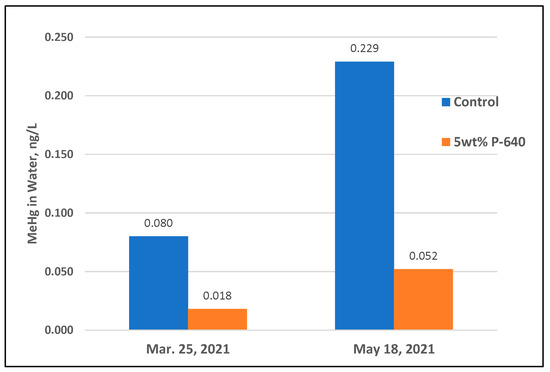
Figure 5.
Site 1 MeHg was significantly reduced in AOC-6 leachate due to MercLok.
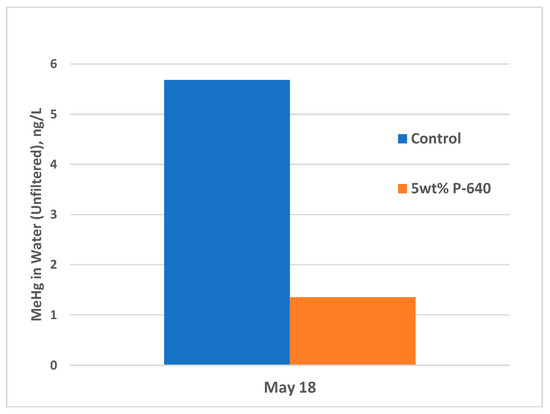
Figure 6.
Site 1 MeHg was significantly reduced in AOC-X leachate due to MercLok.
Sampling and analysis of AOC-X calcines immediately after treatment with MercLok at 10 wt% showed that leachable Hg reduced below the CCR Title 22 limit of 0.2 mg/L (Figure 7).
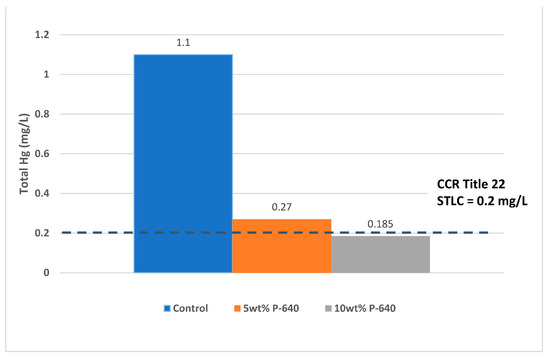
Figure 7.
Site 1 AOC-X solids results for DI-WET extracts during trial setup (5 January 2021).
- 2.
- Site 2 Details
For Site 2, water was added to each MercLok supersack to attain a pourable slurry of 40% solids. The reactive barrier was excavated into the calcine pile’s perimeter soil. Calcines (upgradient) or local sandy soil (downgradient) was mixed with MercLok at approximately 10:1 (base:MercLok) dry weight ratio. The moistened mixture was placed into the trench. About 1800 kg of MercLok was applied in a 30 m trench. The predominately clayey soil excavated from the downgradient trench was compacted into its overlying berm.
The MercLok slurry was placed onto the calcine pile using a backhoe and hand shovels, and scored into the upper one foot of calcines until uniform in appearance (uniform dark color) to achieve about 5% MercLok by weight. Water was also sprayed onto the amended surface, which served to mobilize MercLok from concentrated chunks to less concentrated pockets. About 4500 kg was applied to the calcine pile surface. The amended surface area is about 279 m2.
The amended calcines were track-walked for compaction and graded to ensure positive drainage so that ponding did not occur within the amended calcines and to prepare the amended calcines for the installation of surface flow/erosion control measures including straw mulch, straw wattles and the broadcast seeding of native grasses and forbs. Erosion was monitored through the first rainy season and control features (berms, ditches, and retaining wall) were maintained. Vegetation grew readily on all amended areas.
Upon construction completion, confirmation samples of amended calcines were collected from four areas (one each from the upslope and downslope reactive barriers, and two from the amended calcines), each as a four-point composite sample. The subsamples were then sieved using a 2 mm sieve to remove coarse particles, homogenized in the field and submitted as composite samples for analyses. For quality control, a field duplicate sample and a non-amended sample were also obtained. Standard lab quality control and quality assurance measures were also performed.
The confirmation sample collected from the downgradient trench was analyzed for CAM 17 metals using EPA Methods 6020 and 7471, and for total solids using EPA Method 2540. Confirmation samples collected from both the calcine pile and the upgradient trench were analyzed for Hg using EPA Method 7471 (for comparison with the TTLC) and for total solids using EPA Method 2540, while the waste extraction test (WET) (for comparison with the STLC), and DI WET were employed for comparison with the background and criteria protective of water quality (Table 2).

Table 2.
Comparison of Site 2 Hg in non-amended and amended calcines in confirmation samples.
The mercury concentration in WET extracts from non-amended calcines was 0.44–1.13 mg/L, above the 0.2 mg/L soluble threshold limit concentration (STLC) criterion for California hazardous waste classification (as per 22 CCR Section 66261.24(a)(2)). The mercury concentration in WET extracts from amended calcines was 0.005–0.007 mg/L, which is below the STLC criterion (and less than that in the WET extract from background soil). The mercury concentration in DI WET extracts from non-amended calcines was 0.2–3.46 mg/L, while it was not detected (<0.0010 mg/L) for amended calcines. The mercury concentration in this amended sample extract was about 40 times less than that observed for background soil (0.044 mg/L).
6. Conclusions
For Site 1, the proximity of erosive calcine tailings to surface water and the shallow depths of groundwater at the site indicate that basic site improvements such as erosion control and revegetation are not likely sufficiently protective of water quality. Without amendment, acceptable remedies for these calcines would include excavation, transport and disposal at a suitably permitted off-site disposal facility or an on-site liner and cap system followed by long-term maintenance and monitoring. Both remedies are costly and environmentally disruptive. The ability to amend the calcines with 5 wt% MercLok in either repository cap or reactive barrier hydrologic control configurations in order to remove hazardous leaching characteristics and stabilize Hg at levels protective of water quality under the site conditions makes it possible to construct a Group C on-site repository efficiently and at a lower cost.
The project at Site 2 successfully addressed its goals and objectives. The project team adequately prepared the site, followed its work plan and worker safety protocols, applied MercLok in the intended areas and concentrations using both treatment configurations, and controlled erosion with surface flow hydrologic controls. Confirmation samples document that MercLok treatment effectively controlled Hg leachability in calcines. The amendment of the calcines with MercLok reduced Hg in the leachate to concentrations below those detected in the leachate from background soils and below California hazardous waste classification criteria. With long-term monitoring and maintenance, the site is expected to serve for years to come as a positive example of effective Hg mine site remediation.
The excavation of mine waste and transport for off-site disposal at a permitted facility is often required to remediate contaminated mine sites, and this can be prohibitively expensive, dangerous, and energy-intensive. Similarly, the construction of an engineered, on-site, multi-layered containment system with integrated leachate control and removal system for hazardous wastes is also costly. The amendment of calcines consolidated on-site, treated with MercLok and protected from erosion using routine best management practices, renders the remediation of remote sites feasible.
7. Recommendations for Future Direction
Site 1 warrants remediation based on the site assessments and field testing performed to date. Hydrologic controls recommended to stabilize the site and minimize the downstream transport of mining material and its leachate include (1) recontouring steep waste material piles and revegetating with native, drought-tolerant plants, (2) maintaining the earthen berm separating the adjacent road runoff, (3) partially filling a ditch to prevent further headcut, (4) maintaining the site’s culvert entrance and outlet to ensure that runoff from the upper watershed does not flow through the mining material, and (5) isolating groundwater seepage from the mine waste and repairing rills and gullies in the mine area to prevent continued erosion. On-site calcines should be consolidated and then amended with MercLok as a repository cap with a reactive barrier to control any leachate, and the best management practices should be applied to minimize erosion.
There are many abandoned Hg mines in the Coast Range stemming from its legacy of Hg mining, and a broad set of stakeholders are interested in addressing them as a source of contamination. At prospective Hg mine remediation sites, MercLok may be tested on mine wastes such as waste rock, ore, and overburdens that leach Hg above the threshold for hazardous waste or at concentrations that pose a threat to water quality, as well as calcines to determine if hazardous characteristics can be removed through amendment, and/or if leachable Hg can be reduced to concentrations protective of water quality under site conditions.
Supplementary Materials
The following supporting information can be downloaded at: https://www.mdpi.com/article/10.3390/hydrology10070155/s1. Figure S1: Site 1 photos. (A) Calcine pile hardened and fractured above the stream channel. (B) Sampling leachate from test buckets at Site 1; Figure S2: Site 2 photos. (A) Handling MercLok supersacks for the calcine cap. (B) Digging the lower permeable reactive barrier (left) and filling it with MercLok-amended sandy soil (right). (C) Views of the remediated calcine pile from above (upper) and below (lower) with key components identified. Supplementary Technology Information with additional MercLok stability testing results. Supplementary Table S1 with the total metals in the leachate for Site 1.
Author Contributions
Conceptualization, G.R.; methodology, all; formal analysis, G.R.; investigation, all; resources, J.M. and K.P.; data curation, G.R. and S.M.; writing—original draft preparation, S.M.; writing—review and editing, G.R., J.M. and K.P.; visualization, G.R.; supervision, S.M.; project administration, K.P.; funding acquisition, J.M. and K.P. All authors have read and agreed to the published version of the manuscript.
Funding
This research was partially funded under contract by Albemarle Amendments, LLC, with in-kind contributions from the private landowners of the mine sites. The APC was funded by Albemarle Amendments, LLC.
Data Availability Statement
The data presented in this study are available on request from the corresponding author. The data are not publicly available due to on-going intellectual property work.
Acknowledgments
Lindsay Whalin, Sarah Acker and Keith Roberson at the San Francisco Bay Regional Water Quality Control Board (Board) and Jeff Huggins and Kyle Johnson at the Central Valley Board provided helpful technical review and regulatory oversight. Landowners (anonymous) provided significant in-kind support for accessing the sites, obtaining historical records, protecting equipment, and implementing site improvements.
Conflicts of Interest
Authors S.M. and G.R. were contracted to Albemarle to undertake the projects described. Authors J.M. and K.P. were employed by Albemarle while providing technical input to design and implement the projects, writing the manuscript; and deciding to publish the results. Chemical analyses were performed primarily at certified commercial labs as well as some feasibility and supplemental testing at Albemarle’s research lab.
References
- Jasinksi, S.M. The material flow of mercury in the United States. Resour. Conserv. Recycl. 1995, 15, 145–179. [Google Scholar]
- California State Mining Bureau. In The Quicksilver Resources of California, Bulletin No. 27, 2nd ed.; California State Mining Bureau: San Francisco, CA, USA, 1908.
- Kim, C.S.; Rytuba, J.J.; Brown, G.E. Geological and Geological and Anthropogenic Factors Influencing Mercury Speciation in Mine Wastes: An EXAFS Spectroscopy Study. Appl. Geochem. 2004, 19, 379. [Google Scholar] [CrossRef]
- California Environmental Protection Agency. Available online: https://www.waterboards.ca.gov/water_issues/programs/water_quality_assessment/2020_2022_integrated_report.html (accessed on 25 April 2023).
- California Office of Environmental Health Hazard Assessment. Available online: https://oehha.ca.gov/fish/advisories (accessed on 25 April 2023).
- Eckley, C.S.; Gilmour, C.C.; Janssen, S.; Luxton, T.P.; Randall, P.M.; Whalin, L.; Austin, C. The assessment and remediation of mercury contaminated sites: A review of current approaches. Sci. Total Environ. 2020, 707, 136031. [Google Scholar] [CrossRef] [PubMed]
- Kirchner, J.W.; Austin, C.; Myers, A.; Whyte, D.C. Quantifying Remediation Effectiveness under Variable External Forcing Using Contaminant Rating Curves. Environ. Sci. Technol. 2011, 45, 7874–7881. [Google Scholar] [CrossRef] [PubMed]
- U.S. Bureau of Mines. Mercury Potential of the United States; Information Circular 8252; Bureau of Mines, U.S. Department of the Interior: Washington, DC, USA, 1965. [Google Scholar]
- U.S. Environmental Protection Agency. SW-846 Test Method 1311: Toxicity Characteristic Leaching Procedure, Part of Test Methods for Evaluating Solid Waste, Physical/Chemical Methods; Washington, DC, USA, September 2022. Available online: https://www.epa.gov/hw-sw846/sw-846-test-method-1311-toxicity-characteristic-leaching-procedure (accessed on 24 June 2023).
- U.S. Environmental Protection Agency. SW-846 Test Method 1313: Liquid-Solid Partitioning as a Function of Extract pH Using a Parallel Batch Extraction Procedure; Washington, DC, USA, May 2023. Available online: https://www.epa.gov/hw-sw846/sw-846-test-method-1313-liquid-solid-partitioning-function-extract-ph-using-parallel-batch (accessed on 24 June 2023).
- SW-846 Test Method 1314: Liquid-Solid Partitioning as a Function of Liquid-Solid Ratio for Constituents in Solid Materials Using an Up-Flow Percolation Column Procedure; Washington, DC, USA, May 2022. Available online: https://www.epa.gov/hw-sw846/sw-846-test-method-1314-liquid-solid-partitioning-function-liquid-solid-ratio-constituents (accessed on 24 June 2023).
- Organization for Economic Cooperation and Development. Guideline for Testing of Chemicals. Earthworm Acute Toxicity Tests; OECD: Paris, France, 1984. [Google Scholar]
- U.S. Environmental Protection Agency. Method Guidance and Recommendations for Whole Effluent Toxicity Testing; 40 CFR Part 136, EPA 821-B-00-004; Washington, DC, USA, 2000. Available online: https://www.epa.gov/sites/default/files/2016-02/documents/method-guidance-recommendations-wet-testing_2000.pdf (accessed on 24 June 2023).
- U.S. Environmental Protection Agency. Methods for Measuring the Acute Toxicity of Effluents and Receiving Waters to Freshwater and Marine Organisms, 5th ed.; EPA-821-R-02-012; Washington, DC, USA, 2002. 2002. Available online: https://www.epa.gov/sites/default/files/2015-08/documents/acute-freshwater-and-marine-wet-manual_2002.pdf (accessed on 24 June 2023).
Disclaimer/Publisher’s Note: The statements, opinions and data contained in all publications are solely those of the individual author(s) and contributor(s) and not of MDPI and/or the editor(s). MDPI and/or the editor(s) disclaim responsibility for any injury to people or property resulting from any ideas, methods, instructions or products referred to in the content. |
© 2023 by the authors. Licensee MDPI, Basel, Switzerland. This article is an open access article distributed under the terms and conditions of the Creative Commons Attribution (CC BY) license (https://creativecommons.org/licenses/by/4.0/).